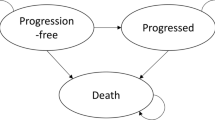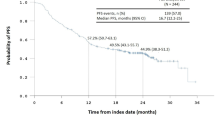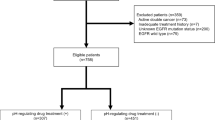Abstract
Objectives
Dichloroacetate (DCA) is a highly bioavailable small molecule that inhibits pyruvate dehydrogenase kinase, promoting glucose oxidation and reversing the glycolytic phenotype in preclinical cancer studies. We designed this open-label phase II trial to determine the response rate, safety, and tolerability of oral DCA in patients with metastatic breast cancer and advanced stage non-small cell lung cancer (NSCLC).
Materials and methods
This trial was conducted with DCA 6.25 mg/kg orally twice daily in previously treated stage IIIB/IV NSCLC or stage IV breast cancer. Growth inhibition by DCA was also evaluated in a panel of 54 NSCLC cell lines with and without cytotoxic chemotherapeutics (cisplatin and docetaxel) in normoxic and hypoxic conditions.
Results and conclusions
Under normoxic conditions in vitro, single-agent IC50 was >2 mM for all evaluated cell lines. Synergy with cisplatin was seen in some cell lines under hypoxic conditions. In the clinical trial, after seven patients were enrolled, the study was closed based on safety concerns. The only breast cancer patient had stable disease after 8 weeks, quickly followed by progression in the brain. Two patients withdrew consent within a week of enrollment. Two patients had disease progression prior to the first scheduled scans. Within 1 week of initiating DCA, one patient died suddenly of unknown cause and one experienced a fatal pulmonary embolism. We conclude that patients with previously treated advanced NSCLC did not benefit from oral DCA. In the absence of a larger controlled trial, firm conclusions regarding the association between these adverse events and DCA are unclear. Further development of DCA should be in patients with longer life expectancy, in whom sustained therapeutic levels can be achieved, and potentially in combination with cisplatin.




Similar content being viewed by others
References
Aykin-Burns N, Slane BG, Liu ATY et al (2011) Sensitivity to low-dose/low-LET Ionizing radiation in mammalian cells harboring mutations in succinate dehydrogenase Subunit C is governed by mitochondria-derived reactive oxygen species. Radiat Res 175:150–158
Ayyanathan K, Kesaraju S, Dawson-Scully K, Weissbach H (2012) Combination of Sulindac and dichloroacetate kills cancer cells via oxidative damage. PLoS ONE 7:e39949
Bensaad K, Tsuruta A, Selak MA et al (2006) TIGAR, a p53-Inducible Regulator of Glycolysis and Apoptosis. Cell 126:107–120
Bonnet Sb, Archer SL, Allalunis-Turner J et al (2007) A mitochondria-K + channel axis is suppressed in cancer and its normalization promotes apoptosis and inhibits cancer growth. Cancer Cell 11:37–51
Brahimi-Horn MC, Ben-Hail D, Ilie M et al (2012) Expression of a truncated active form of VDAC1 in lung cancer associates with hypoxic cell survival and correlates with progression to chemotherapy resistance. Cancer Res 72:2140–2150
Buzzai M, Bauer DE, Jones RG et al (2005) The glucose dependence of Akt-transformed cells can be reversed by pharmacologic activation of fatty acid [beta]-oxidation. Oncogene 24:4165–4173
Chou TC (2010) Drug combination studies and their synergy quantification using the Chou–Talalay method. Cancer Res 70:440–446
Common Terminology Criteria for Adverse Events (2006) Version 3.0. Bethesda, MD: NCI [cited 2012 Oct 19]. Available from: http://ctep.cancer.gov
Curry SH, Chu PI, Baumgartner TG et al (1985) Plasma concentrations and metabolic effects of intravenous sodium dichloroacetate. Clin Pharm Ther 37:89–93
Dakubo GD (2010) The Warburg phenomenon and other metabolic alterations of cancer cells. Mitochondrial genetics and cancer, 1st edn. Springer, Heidelberg, p 39–62
Dhar S, Lippard SJ (2009) Mitaplatin, a potent fusion of cisplatin and the orphan drug dichloroacetate. Proc Natl Acad Sci 106:22199–22204
Edelman MJ, Harb WA, Pal SE (2012) Multicenter trial of EC145 in advanced, folate-receptor positive adenocarcinoma of the lung. J Thorac Oncol 7:1618–1621
Elstrom RL, Bauer DE, Buzzai M et al (2004) Akt stimulates aerobic glycolysis in cancer cells. Cancer Res 64:3892–3899
Feuerecker B, Pirsig S, Seidl C et al (2012) Lipoic acid inhibits cell proliferation of tumor cells in vitro and in vivo. Cancer Biol Ther 13(14):1425–1435
Fiebiger W, Olszewski U, Ulsperger E et al (2011) In vitro cytotoxicity of novel platinum-based drugs and dichloroacetate against lung carcinoid cell lines. Clin Transl Oncol 13:43–49
Garon EB, Finn RS, Hamidi H et al (2013a) The HSP90 inhibitor NVP-AUY922 potently inhibits non-small cell lung cancer growth. Mol Cancer Ther 12(6):890–900
Garon EB, Pietras RJ, Finn RS et al (2013b) Antiestrogen fulvestrant enhances the antiproliferative effects of epidermal growth factor receptor inhibitors in human non-small-cell lung cancer. J Thorac Oncol 8(3):270-278
Gatenby RA, Gillies RJ (2004a) Why do cancers have high aerobic glycolysis? Nat Rev Cancer 4:891–899
Gatenby RA, Gillies RJ (2004b) Why do cancer cells have high aerobic glycolysis? Nat Rev Cancer 4:891–899
Howlader NNA, Krapcho M, Neyman N, et al (2012) Cancer Stat Rev, 1975–2009 (Vintage 2009 Populations). August 20, 2012 [cited 2012 September 14]; http://seer.cancer.gov/csr/1975_2009_pops09/
Hu Y, Lu W, Chen G et al (2012) K-rasG12 V transformation leads to mitochondrial dysfunction and a metabolic switch from oxidative phosphorylation to glycolysis. Cell Res 22:399–412
Jia M, Coats B, Chadha M et al (2006) Human kinetics of orally and intravenously administered low-dose 1,2-13C-dichloroacetate. J Clin Pharmacol 46:1449–1459
Ke Q, Costa M (2006) Hypoxia-inducible factor-1 (HIF-1). Mol Pharmacol 70:1469–1480
Kluza J, Corazao-Rozas P, Touil Y et al (2012) Inactivation of the HIF-1a/PDK3 signaling axis drives melanoma toward mitochondrial oxidative metabolism and potentiates the therapeutic activity of pro-oxidants. Cancer Res 72:5035–5047
Lichtenfeld L. DCA: Cancer breakthrough or urban legend? ABC World News. [cited 2012 Oct 28]. http://abcnews.go.com/Health/CancerPreventionAndTreatment/story?id=2848454&page=1#.UI6j2m-jz7o. 2007
Loscalzo J (2010) The cellular response to hypoxia: tuning the system with microRNAs. J Clin Invest 120:3815–3817
Mathews CK, Holde Kv, Ahern KG (2000) Electron transport, oxidative phosphorylation, and oxygen metabolism. Biochemistry, 3rd edn. Benjamin/Cummings, San Francisco, p 522–557
Mathews CK, Holde Kv, Ahern KG (2000) Carbohydrate metabolism I: Anaerobic processes in generating metabolic energy. Biochemistry, 3rd edn. Benjamin/Cummings, San Francisco, p 446–482
Michelakis ED, Sutendra G, Dromparis P et al (2010) Metabolic modulation of glioblastoma with dichloroacetate. Sci Transl Med 2:31ra4
Morfouace M, Lalier L, Bahut M et al (2012) Comparison of spheroids formed by rat glioma stem cells and neural stem cells reveals differences in glucose metabolism and promising therapeutic applications. J Biol Chem 287:33664–33674
Oken MM, Creech RH, Tormey DC et al (1982) Toxicity and response criteria of the eastern cooperative oncology group. Am J Clin Oncol 5:649–656
Pfeffer G, Majamaa K, Turnbull DM et al (2012) Treatment for mitochondrial disorders. The Cochrane Library 4:CD004426
Remillard CV, Yuan JXJ (2004) Activation of K + channels: an essential pathway in programmed cell death. Am J Physiol Lung Cell Mol Physiol 286:L49–L67
Ruckenstuhl C, Büttner S, Carmona-Gutierrez D et al (2009) The Warburg effect suppresses oxidative stress induced apoptosis in a yeast model for cancer. PLoS ONE 4:e4592
Saed GM, Fletcher NM, Jiang ZL et al (2011) Dichloroacetate induces apoptosis of epithelial ovarian cancer cells through a mechanism involving modulation of oxidative stress. Reprod Sci 18:1253–1261
Spira A, Ettinger DS (2004) Multidisciplinary management of lung cancer. N Engl J Med 350:379–392
Stacpoole PW, Kerr DS, Barnes C et al (2006) Controlled clinical trial of dichloroacetate for treatment of congenital lactic acidosis in children. Pediatrics 117:1519–1531
Sutendra G, Dromparis P, Kinnaird A et al (2013) Mitochondrial activation by inhibition of PDKII suppresses HIF1a signaling and angiogenesis in cancer. Oncogene 32:1638–1650
The DCA Site. [cited 2012 Oct 19]. Available from: http://www.thedcasite.com/index.html
Vander Heiden MG, Cantley LC, Thompson CB (2009) Understanding the Warburg Effect: the metabolic requirements of cell proliferation. Science 324:1029–1033
Warburg O (1956) On the origin of cancer cells. Science 123:309–314
World Health Organization Cancer Fact Sheet (2012) February 2012 [cited 2012 September 12]; http://www.who.int/mediacentre/factsheets/fs297/en/
Xue X, You S, Zhang Q et al (2012) Mitaplatin increases sensitivity of tumor cells to cisplatin by inducing mitochondrial dysfunction. Mol Pharm 9:634–644
Ying H, Kimmelman Alec C, Lyssiotis Costas A et al (2012) Oncogenic Kras maintains pancreatic tumors through regulation of anabolic glucose metabolism. Cell 149:656–670
Acknowledgments
Funding for this project came from K23CA149079, NIH CTSI UL1TR000124, the Lincy Foundation, the Aljian Family Trust in Memory of James Aljian, the Hecht Foundation, the Wolfen Family Clinical/Translational Lung Cancer Research Program, the Katz Family, and the One Ball Matt Golf Tournament.
Conflict of interest
The authors have no conflicts of interest to report.
Author information
Authors and Affiliations
Corresponding author
Additional information
Clinical Trial Registration Number: NCT01029925.
Rights and permissions
About this article
Cite this article
Garon, E.B., Christofk, H.R., Hosmer, W. et al. Dichloroacetate should be considered with platinum-based chemotherapy in hypoxic tumors rather than as a single agent in advanced non-small cell lung cancer. J Cancer Res Clin Oncol 140, 443–452 (2014). https://doi.org/10.1007/s00432-014-1583-9
Received:
Accepted:
Published:
Issue Date:
DOI: https://doi.org/10.1007/s00432-014-1583-9




